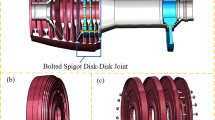Abstract
Energy dissipation at the interfaces of the mechanical joints is the primary source of damping in many rotor dynamics structures as well as built-up structures. In the majority of structures, micro- and macro-slips at the interfaces are the mechanisms for energy dissipation. Modelling of the dissipation using detailed finite element (FE) of the joint interfaces is computationally very expensive. Consequently, it places severe restrictions in the application of detailed FE methods to real-life structures for capturing energy dissipation at joints. In the present work, a reduced-order Masing’s model is adopted to model overlapping joint interfaces. The dynamic contact of the overlapping interface is captured using coupled normal and tangential Masing’s contact rate forms in commercial FE software through the user-defined subroutine. Masing’s parameters are established from the detailed FE model of isolated bolt structure. It is found that the reduced-order modelling is well suitable for capturing dissipation energies without the need for the detailed finite element methods.
Access this chapter
Tax calculation will be finalised at checkout
Purchases are for personal use only
Similar content being viewed by others
References
Kuratani F, Hirai T, Koide K, Kido I (2013) Damping in jointed friction plates with partially overlapping interfaces. In: RASID 2013, 11th international conference
Beards CF (1992) Damping in structural joints. Shock Vibr Dig 24:3–7
Ahmadian H, Jalali H (2007) Identification of bolted lap joints parameters in assembled structures. Mech Syst Sig Process 21:1041–1050
Ibrahim RA (1994) Friction-induced vibration, chatter, squeal, and chaos—part I: mechanics of contact and friction. ASME Appl Mech Rev 47(7):209–226
Ibrahim RA (1994) Friction-induced vibration, chatter, squeal, and chaos—Part II: dynamics and modeling. ASME Appl Mech Rev 47(7):227–253
Chen W, Deng X (1999) A finite element analysis of friction damping in a slip joint, DETC99/VIB-8189. In: Proceedings of 1999 ASME design engineering technical conferences, Las Vegas
Lee S-Y, Ko K-H, Lee JM (2000) Analysis of dynamic characteristics of structural joints using stiffness influence coefficients. KSME Int J 14:1319–1327
Oldfield MJ, Ouyang H, Mottershead JE (2005) Simplified models of bolted joints under harmonic loading. Comput Struct 84:25–33
Masing G (1923) Zur Heynschen Theorie der Verfestigung der Metalle durch verborgene elastische Spannungen. Wissenschaftliche Veroffentlichungen aus dem Siemens-Konzern 3:231–239
Segalman DJ (2006) Modeling contact friction in structural dynamics. Struct. Control Health Monit 13:430–453
ANSYS (2017) A mechanical APDL, programmer’s reference, guide to user-programmable features, SAS IP, INC
Acknowledgements
The project is partially supported by AR&DB, India, with project number 1824.
Author information
Authors and Affiliations
Corresponding author
Editor information
Editors and Affiliations
Rights and permissions
Copyright information
© 2021 Springer Nature Singapore Pte Ltd.
About this paper
Cite this paper
Vamsi Krishna, G., Viswanath, C., Pandey, A.K. (2021). Performance of Bolted Joint Modelling Using Master Element. In: Rao, J.S., Arun Kumar, V., Jana, S. (eds) Proceedings of the 6th National Symposium on Rotor Dynamics. Lecture Notes in Mechanical Engineering. Springer, Singapore. https://doi.org/10.1007/978-981-15-5701-9_48
Download citation
DOI: https://doi.org/10.1007/978-981-15-5701-9_48
Published:
Publisher Name: Springer, Singapore
Print ISBN: 978-981-15-5700-2
Online ISBN: 978-981-15-5701-9
eBook Packages: EngineeringEngineering (R0)




